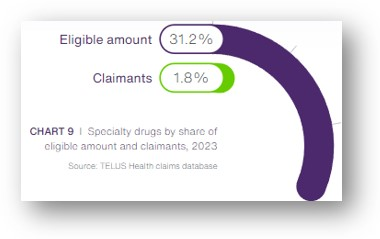Steps that plan sponsors can take to manage the increasing costs of benefits plans and promote financial sustainability

Rising drug costs are a major factor driving up benefit plan expenses. They can affect the overall financial sustainability of a plan, even affecting coverage for plan members. In 2023, specialty drugs accounted for 31.2 percent of drug costs, and the number of claimants continues to increase (Telus Health 2024 Drug Data Trends & National Benchmarks report).

The purpose of this article is to highlight how traditional risk insurance products leave organizations exposed to high-cost drug claims, and what strategies one should consider to mitigate risk.
Most organizations offer unlimited prescription medication coverage. Typically built into their extended healthcare premiums is a risk insurance product that helps reduce exposure, called stop loss insurance. It is usually set at a per-individual level, and the threshold is often set around $10,000 per person. This means the first $10,000 of a claimed high-cost drug will have a direct impact on claims renewal calculations. The rest will move to a large-amount pool (LAP). The insurer absorbs any cost over the LAP threshold. The smaller the company, the more impact just one claim can have on renewal rates. It would be challenging to market the plan knowing insurers will be wary of taking on that LAP burden.
To better understand this, let us examine the example of auto insurance. If a claim is submitted, the deductible is paid first, then the insurance company covers the balance. At renewal time, it is likely rates will increase due to the cost absorbed by insurer. Similarly, in a benefits environment, rates will increase annually so long as that high-cost drug is claimed, until the plan member resigns, retires, or passes away.
To avoid this undesirable condition, best practice encourages the following strategies. First, consider changing from per individual to per certificate.
|
|
|
|
$10,000 per individual Stop Loss |
$12,500 Per Certificate Stop Loss |
|
|---|---|---|---|---|---|
|
|
|
|
$10,000 |
$12,500 |
|
|
|
|
|
|
|
|
|
|
|
Approximate dependent conversion per family |
"Current" |
"Certificate" |
|
|
Single |
30 |
|
$300,000 |
$375,000 |
|
|
Family |
70 |
3.00 |
$2,100,000 |
$875,000 |
|
|
|
$2,400,000 |
$1,250,000 |
|
||
|
|
|||||
|
|
|
|
|
|
|
|
|
Total Liability |
$2,400,000 |
$1,250,000 |
|
|
Per individual means every insured member has their own stop-loss product. Per certificate treats every plan member, whether single or family, as a certificate, thereby reducing total theoretical risk.
Second, install formulary guard (FG), which is a specialty drug-management program developed in partnership with Bayshore Health and People Corporation. FG extends plan member support in securing alternative funding for their medication. This approach manages the impact of rising drug costs, starting with a thorough analysis of a company’s drug claim history to assess exposure to high-cost drugs. The goal is to identify funding sources before the company incurs the cost, exploring three avenues:
- Alternative private plan (e.g., spousal co-ordination of benefits)
- Provincial health programs
- Drug manufacturer-sponsored programs
People Corporation’s Nadia Lubsey, operations manager – health solutions, recently provided the following insight about the FG process: “After the claims history analysis, we communicate to all stakeholders to educate them about the FG program. Then, the plan member engages with a specialist to investigate alternative funding sources. Our specialists support members through the entire process, assisting with the completion and submission of required forms, coordinating with the different funders, and managing referrals.”
Success story: “Since launching FG in June 2020, we have successfully secured alternative funding for over 200 cases, resulting in over $7 million in cost savings to our clients.”
Comparable products: “Yes, some offer managed formularies that simply exclude high-cost drugs from the plan. However, those programs do not match the level of plan-member support FG provides. Ours is a strategic solution that provides a comprehensive health solution with hands-on support throughout the treatment journey.”
The traditional per-individual risk insurance is archaic, especially given the rising cost of drugs and its associated risk. Rather, employing the above strategies – stop-loss per certificate coupled with formulary guard – can protect your organization’s risk and provide an empowering relief against current and future trends. Here is the future benefit: reducing claims means healthier renewals and healthier sustainable relationships among all stakeholders.
Jamil Jamal and Jeffrey Stinchcombe – partners, benefits consultants at people corporation



